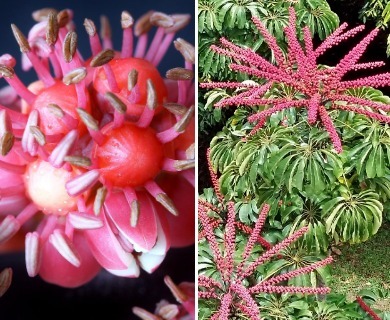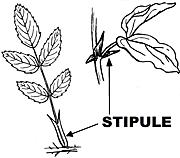Octopus Tree
Heptapleurum actinophyllum
Ivy/Pennywort/Devil's Club family (Araliaceae)
Post-Cook introduction
This distinctive ornamental is easily recognized by the several trunks mostly unbranched, the few very large leaves with 7–12 slightly drooping in a circle at end of long leafstalk as in an umbrella, and the large showy clusters of many dark red or crimson flowers on 10–20 widely spreading dark purple axes suggesting arms of an octopus.

©2017 Mauricio Mercadante
Leaves (), about 2–3 ft (0.6–0.9 ) long. leaf-stalks very long, 1–2 ft (0.3–0.6 ), relatively slender, enlarged at both ends, round, light green. In angle above leafstalk, also forming a bud at the end of twig, is a light green or very narrow long-pointed 1 1⁄2–2 inches (4–5 ) long. are mostly 7–12 (5–18), spreading in a circle at the end of leafstalk on slender, spoke-like stalks of 2–4 1⁄2 inches (5–11 ). blades oblong or elliptical, mostly 6–12 inches (15–30 ) long and 3–5 inches (7.5–13 ) broad, rounded and abruptly short-pointed at rounded or short-pointed at base, slightly turned under at edges, slightly thickened and leathery. Upper surface shiny dark green with grooved light green and inconspicuous side veins, and lower surface dull light green with slightly raised veins.
Flower clusters () are large, composed of 10–20 widely spreading stout axes. Flowers are borne 10–12, crowded, stalkless, in rounded heads 3⁄4 inch (2 ) across on dark purple stalks of 3⁄8–1⁄2 inch (10–13 ) along the axis. Top half of the rounded dark red bud nearly 1⁄4 inch (6 ) in diameter is composed of 10–12 narrow pointed thick petals 3⁄16 inch (5 ) long, dark red on outer surface and whitish on inner surface, shedding early as half-round cap. Other flower parts are of the same number as petals, represented by narrow rim with minute teeth. 10–12, 3⁄16 inch (5 ) long, red, with stout filaments and large erect and slightly spreading 3⁄8–1⁄2 inch (10–13 ) across, soon shedding. half-round, turning from light to dark red, consists of inferior whitish within and slightly resinous and aromatic, with 10–12 narrow cells each containing one ovule, and the same number of dot stigmas in the ring.
In the head is composed of 10–12 berries, each bordered by four brownish black in the form of a cup, which is after shedding. round or top-shaped, blackish, 1⁄4 inch (6 ) in diameter, with ring of stigmas at ring slightly above middle, also vertical ridges corresponding to the 10–12 cells. Seed (nutlet), one in each cell, elliptical, flattened, brown, 1⁄8 inch (3 ) long. Flowering from April to October in Hawaii.
Wood is soft, not durable, not used.
Propagated from cuttings and seeds. The plants will grow in poor sand and can be pruned and topped. The seeds sometimes germinate on other trees and send roots down to the ground.
Common as an ornamental in lowlands of Hawaii and escaping from cultivation, becoming a real tree weed. Introduced about 1900.
In southern and central Florida, this popular small tree is recommended for tropical effect in confined areas of office buildings, parking lots, patios, and. homes. However, the berries stain sidewalks. This species withstands a few degrees of freezing temperature and flowers in about 10 years where located in the sun. Northward, it is grown indoors as a potted plant for the handsome foliage. Cultivated also in Puerto Rico.
Special areas
Waimea Arboretum, Foster, Tantalus, lolani
Champion
Height 50 ft (15.3 ), c.b.h. 17.3 ft (5.3 ), spread 58 ft (17.7 ). State Forestry Arboretum, Hilo, Hawaii (1968).
Range
Native to Queensland, Australia. Introduced as an ornamental through the tropics and as a potted plant northward in temperate regions.
Other common names
umbrella-tree, brassaia, schefflera
Botanical
Brassaia actinophylla Endl., Schefflera actinophylla (Endl.) Harms









